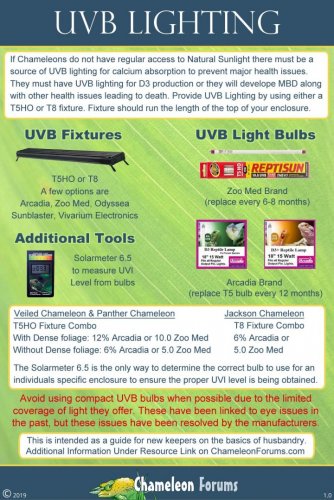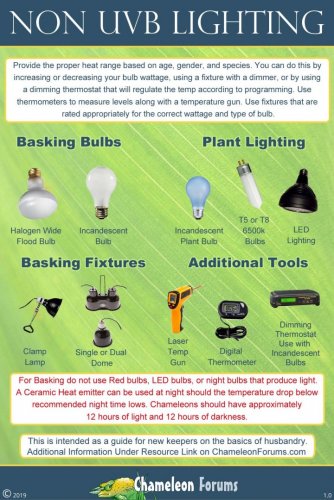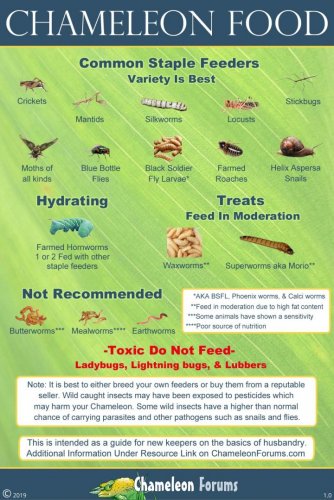Navigation
Install the app
How to install the app on iOS
Follow along with the video below to see how to install our site as a web app on your home screen.
Note: This feature may not be available in some browsers.
More options
You are using an out of date browser. It may not display this or other websites correctly.
You should upgrade or use an alternative browser.
You should upgrade or use an alternative browser.
Reptile Fogger Help
- Thread starter Ortiz4541
- Start date
Daesie11
Chameleon Enthusiast
Having high humidity during the day when the heat is also high can lead to respiratory issues. Foggers should only be used at night when your temps are 68ish and below. You may never see your cham drink, but if their eye turrets arent sunken and their urates are a pearly white, then you know they are well hydrated 
Thank you do you know if it’s ok if my hydrometer goes below 40-30% during the day because that’s what happens if I don’t have the Fogger on.Having high humidity during the day when the heat is also high can lead to respiratory issues. Foggers should only be used at night when your temps are 68ish and below. You may never see your cham drink, but if their eye turrets arent sunken and their urates are a pearly white, then you know they are well hydrated
Daesie11
Chameleon Enthusiast
I'm not super familiar with the humidity requirements of veileds, so I'll let someone who is chime in on that, but there are definitely other ways of maintaining humidity during the day without a fogger. Being from Colorado, I feel like I'm allowed to say if I can do it you can do it  what sort of misting schedule do you have? Live plants? What sort of enclosure do you have?
what sort of misting schedule do you have? Live plants? What sort of enclosure do you have?
Can you fill this out and we can try and see what tweaks you can make to help get your humidity where you need it and include pictures if possible! We love to see chams and enclosures
and include pictures if possible! We love to see chams and enclosures
Chameleon Info:
Cage Info:
Can you fill this out and we can try and see what tweaks you can make to help get your humidity where you need it
Chameleon Info:
- Your Chameleon - The species, sex, and age of your chameleon. How long has it been in your care?
- Handling - How often do you handle your chameleon?
- Feeding - What are you feeding your cham? What amount? What is the schedule? How are you gut-loading your feeders?
- Supplements - What brand and type of calcium and vitamin products are you dusting your feeders with and what is the schedule?
- Watering - What kind of watering technique do you use? How often and how long to you mist? Do you see your chameleon drinking?
- Fecal Description - Briefly note colors and consistency from recent droppings. Has this chameleon ever been tested for parasites?
- History - Any previous information about your cham that might be useful to others when trying to help you.
Cage Info:
- Cage Type - Describe your cage (Glass, Screen, Combo?) What are the dimensions?
- Lighting - What brand, model, and types of lighting are you using? What is your daily lighting schedule?
- Temperature - What temp range have you created (cage floor to basking spot)? Lowest overnight temp? How do you measure these temps?
- Humidity - What are your humidity levels? How are you creating and maintaining these levels? What do you use to measure humidity?
- Plants - Are you using live plants? If so, what kind?
- Placement - Where is your cage located? Is it near any fans, air vents, or high traffic areas? At what height is the top of the cage relative to your room floor?
- Location - Where are you geographically located?
I’m from Arizona so we definitely have dry air/heat here so humidity is hard to deal with even indoors haha I am concerned about his color and the darkness around his eyes does he look okay? He is only this color during the day he turns bright green at night. Pictures below.I'm not super familiar with the humidity requirements of veileds, so I'll let someone who is chime in on that, but there are definitely other ways of maintaining humidity during the day without a fogger. Being from Colorado, I feel like I'm allowed to say if I can do it you can do itwhat sort of misting schedule do you have? Live plants? What sort of enclosure do you have?
Can you fill this out and we can try and see what tweaks you can make to help get your humidity where you need itand include pictures if possible! We love to see chams and enclosures
Chameleon Info:
- Your Chameleon - The species, sex, and age of your chameleon. How long has it been in your care?
- Handling - How often do you handle your chameleon?
- Feeding - What are you feeding your cham? What amount? What is the schedule? How are you gut-loading your feeders?
- Supplements - What brand and type of calcium and vitamin products are you dusting your feeders with and what is the schedule?
- Watering - What kind of watering technique do you use? How often and how long to you mist? Do you see your chameleon drinking?
- Fecal Description - Briefly note colors and consistency from recent droppings. Has this chameleon ever been tested for parasites?
- History - Any previous information about your cham that might be useful to others when trying to help you.
Cage Info:
- Cage Type - Describe your cage (Glass, Screen, Combo?) What are the dimensions?
- Lighting - What brand, model, and types of lighting are you using? What is your daily lighting schedule?
- Temperature - What temp range have you created (cage floor to basking spot)? Lowest overnight temp? How do you measure these temps?
- Humidity - What are your humidity levels? How are you creating and maintaining these levels? What do you use to measure humidity?
- Plants - Are you using live plants? If so, what kind?
- Placement - Where is your cage located? Is it near any fans, air vents, or high traffic areas? At what height is the top of the cage relative to your room floor?
- Location - Where are you geographically located?
Chameleon Info:
- Your Chameleon - Veiled, Male, and roughly 4-5 months old. Been in my care for about a week.
- Handling - I have held him 3 times since having him.
- Feeding - Feeding him large crickets. 5-6 crickets a day I put them in his cage in the morning. Not to sure how to gut load feeders. I do have/use high calcium cricket feed if that’s what that means.
- Supplements - I use zoo med reptile calcium without d3. I dust the crickets every other day.
- Watering - I have a dripper and a Fogger. I mist his cage 2x a day for about 15sec. Hardly ever do I see him drink only when I spray directly in front of him.
- Fecal Description - Poop Normal color. Urate is very slightly yellow mostly white. Has this chameleon ever been tested for parasites? No
- History - N/A
Cage Info:
- Cage Type - Describe your cage (Glass, Screen, Combo?) - screen cage 4ft tall 2ft wide.
- Lighting - Zoo Med tropical uvb and heating kit. daily lighting schedule- 9am-9pm on. 9pm- 9am off
- Temperature - basking spot 82, bottom of cage 75. overnight temp?- lowest 70. How do you measure these temps? 2 electric thermometers
- Humidity - What are your humidity levels? 30-40% when foggers off. 60-70% when on. How are you creating and maintaining these levels? Fogger, Dripper, and hand misting. What do you use to measure humidity? Hydrometer
- Plants - Are you using live plants? If so, what kind? Not yet. Have an umbrella plant haven’t put in cage yet.
- Placement - Where is your cage located? I’m my room. Is it near any fans, air vents, or high traffic areas? Near vent but my room temp is normally 77 and only turn on fan when cage is covered. At what height is the top of the cage relative to your room floor? 5feet
- Location - Where are you geographically located? Phoenix, Arizona, USA
Last edited:
Carlton
Chameleon Enthusiast
You don't want or need constant humidity. I've kept chams in very dry climates too (CO at 9000 ft elevation; house humidity hovered around 20% at best). Providing enough humidity for a cham depends on more than a fogger. It is a combination of hand spraying, enough foliage in the cages to absorb, hold, and slowly release moisture over time, as well as a couple of fogging cycles during the 24 hour period. The montane species also got some water directly by syringe...I tried to teach each to accept this and most did. A very direct way to observe how much they drank each day. A well-hydrated cham will drink less, be less obviously thirsty when it does, and will have some "buffer" to get through a drier period. It is chronic even modest dehydration over time that causes problems, not one or two drier than normal days. Its the percentage of TIME that the humidity level stays too low that matters, not whether it ever drops too low.Thank you do you know if it’s ok if my hydrometer goes below 40-30% during the day because that’s what happens if I don’t have the Fogger on.
What I found worked well on a daily basis was to hand mist the cham cages before leaving for work in the morning, set the foggers (ultrasonic room humidifiers controlled by plug in multiple setting timers) to create a humidity peak at about midday, and then I'd hand mist in late afternoon before the lights went off for the night. Of course keeping a close eye on the hygrometers and checking to make sure they were registering accurately. At some drier seasons there was a fog cycle at about midnight, but it depended on which cham setup it was. Drier climate species didn't get it (verrucosus, veiled). The montanes did (melleri, deremensis, fischeri, cristatus). Each fogging cycle lasted long enough to saturate the cage, plants, potting soil. The cycles were far enough apart that the cage and furnishings were able to dry out for a while.
Last edited:
CamoChameleonsHuman
Chameleon Enthusiast
I too am in Colorado. I choose not to use a fogger at all. My mister goes off every 4hrs for 1 min during the day only. I have a cool mist ultrasonic humidifier that I barely use during the day (usually on low setting) and crank it up at night. This has allowed me to keep my Panthers at 50-60% during the day and 80-90% at night. I usually never see my chams drinking but always have full turrets and white urates.You don't want or need constant humidity. I've kept chams in very dry climates too (CO at 9000 ft elevation; house humidity hovered around 20% at best). Providing enough humidity for a cham depends on more than a fogger. It is a combination of hand spraying, enough foliage in the cages to absorb, hold, and slowly release moisture over time, as well as a couple of fogging cycles during the 24 hour period. The montane species also got some water directly by syringe...I tried to teach each to accept this and most did. A very direct way to observe how much they drank each day. A well-hydrated cham will drink less, be less obviously thirsty when it does, and will have some "buffer" to get through a drier period. It is chronic even modest dehydration over time that causes problems, not one or two drier than normal days. Its the percentage of TIME that the humidity level stays too low that matters, not whether it ever drops too low.
What I found worked well on a daily basis was to hand mist the cham cages before leaving for work in the morning, set the foggers (ultrasonic room humidifiers controlled by plug in multiple setting timers) to create a humidity peak at about midday, and then I'd hand mist in late afternoon before the lights went off for the night. Of course keeping a close eye on the hygrometers and checking to make sure they were registering accurately. At some drier seasons there was a fog cycle at about midnight, but it depended on which cham setup it was. Drier climate species didn't get it (verrucosus, veiled). The montanes did (melleri, deremensis, fischeri, cristatus). Each fogging cycle lasted long enough to saturate the cage, plants, potting soil. The cycles were far enough apart that the cage and furnishings were able to dry out for a while.
Daesie11
Chameleon Enthusiast
Thank you for filling out the form! I'm glad you did, because there are a lot of things that you'll be needing to change. The good news is though, they are all very easy to changeI’m from Arizona so we definitely have dry air/heat here so humidity is hard to deal with even indoors haha I am concerned about his color and the darkness around his eyes does he look okay? He is only this color during the day he turns bright green at night. Pictures below.
Chameleon Info:
- Your Chameleon - Veiled, Male, and roughly 4-5 months old. Been in my care for about a week.
- Handling - I have held him 3 times since having him.
- Feeding - Feeding him large crickets. 5-6 crickets a day I put them in his cage in the morning. Not to sure how to gut load feeders. I do have/use high calcium cricket feed if that’s what that means.
- Supplements - I use zoo med reptile calcium without d3. I dust the crickets every other day.
- Watering - I have a dripper and a Fogger. I mist his cage 2x a day for about 15sec. Hardly ever do I see him drink only when I spray directly in front of him.
- Fecal Description - Poop Normal color. Urate is very slightly yellow mostly white. Has this chameleon ever been tested for parasites? No
- History - N/A
Cage Info:
- Cage Type - Describe your cage (Glass, Screen, Combo?) - screen cage 4ft tall 2ft wide.
- Lighting - Zoo Med tropical uvb and heating kit. daily lighting schedule- 9am-9pm on. 9pm- 9am off
- Temperature - basking spot 82, bottom of cage 75. overnight temp?- lowest 70. How do you measure these temps? 2 electric thermometers
- Humidity - What are your humidity levels? 30-40% when foggers off. 60-70% when on. How are you creating and maintaining these levels? Fogger, Dripper, and hand misting. What do you use to measure humidity? Hydrometer
- Plants - Are you using live plants? If so, what kind? Not yet. Have an umbrella plant haven’t put in cage yet.
- Placement - Where is your cage located? I’m my room. Is it near any fans, air vents, or high traffic areas? Near vent but my room temp is normally 77 and only turn on fan when cage is covered. At what height is the top of the cage relative to your room floor? 5feet
- Location - Where are you geographically located? Phoenix, Arizona, USAView attachment 235363View attachment 235364
- Your Chameleon - Veiled, Male, and roughly 4-5 months old. Been in my care for about a week. Before we get too far I want to remind you that he is still new! He is young and he is in a new environment. He is still getting used to the new tree he is living in and will probably be acclimating for awhile. My boy took almost a month before he really settled in completely. I was stressed for that entire month, so I'm not saying it's easy, just that it's normal
- Handling - I have held him 3 times since having him. Chameleons are not meant to be social, cuddly pets, the more you handle him right now, the more stressed he will be which can cause health issues quicker. Try to keep handling to a minimum and always ONLY on his terms. As he gets more acclimated to his environment you can work on some positive reinforcement training that CAN get him to want to come out to you more often, but there is no guarantee. I will tag some keepers who can explain more on this at the end.
- Feeding - Feeding him large crickets. 5-6 crickets a day I put them in his cage in the morning. Not to sure how to gut load feeders. I do have/use high calcium cricket feed if that’s what that means. You MUST start gut loading properly. I will attach a document that explains gutloading as well as what gutloads you should buy. Without gutloading your feeders, they will not have the proper nutritional benefits that your cham needs and thus he will be very vitamin deficient. All you have to do is keep your feeders in a well ventilated storage bin and make sure they have clean, fresh green leafy veggies. Again, see the image I have attached. Also, what actual size crickets are you trying to feed him? If he is really 4-5 months, "large" crickets may be too big and he may not eat them. Juvenile chams should be eating far more than 4-5 crickets, but that does depend on the size of them, and the acclimation process will effect this as well.
- Supplements - I use zoo med reptile calcium without d3. I dust the crickets every other day. dust the crickets without d3 every day. You'll also need a calcium WITH d3 and a multivitamin to use every other week on an alternating schedule.
- Watering - I have a dripper and a Fogger. I mist his cage 2x a day for about 15sec. Hardly ever do I see him drink only when I spray directly in front of him. you will want to mist for at LEAST 1 minute for each session. 15 seconds isnt enough time to trigger their drinking reflex or for them to clean their eyes. Set a timer when you start misting, and just mist continuously for 1+ minute. If you're having issues with humidity, maybe do more. Also, what type of water are you using? You should be using distilled or RO water. I would also recommend getting an automatic misting system like a Mistking or a Climist so that if you're ever not home for some reason your cham still gets the water needed.
- Fecal Description - Poop Normal color. Urate is very slightly yellow mostly white. Has this chameleon ever been tested for parasites? No it is always recommended to get a fecal exam done when you get a new cham, just to make sure theres no preexisting parasites
- History - N/A
Cage Info:
- Cage Type - Describe your cage (Glass, Screen, Combo?) - screen cage 4ft tall 2ft wide. this is great! Way to start off at the right size cage off the bat. Most start small and have to eventually upgrade (me
) if you're having issues with humidity, I would recommend finding some way to cover a few sides of your enclosure. I used a Duck Tale brand window insulation kit and it is amazing! It cost me $5 and it did such a good job keeping in humidity that i had to take a few sides off. You can also just get a shower curtain or a blanket to wrap the enclosure with.
- Lighting - Zoo Med tropical uvb and heating kit. daily lighting schedule- 9am-9pm on. 9pm- 9am off so your lighting schedule is spot on, but I'm assuming when you said "kit" you mean a double dome feature with a coil UVB? That does produce nearly enough UVB, and if you continue using it your cham will end up with MBD. This may also be the cause for your chams brownish color. This should be the FIRST thing you fix. I'll attach an image of what you should get.
- Temperature - basking spot 82, bottom of cage 75. overnight temp?- lowest 70. How do you measure these temps? 2 electric thermometers
- Humidity - What are your humidity levels? 30-40% when foggers off. 60-70% when on. How are you creating and maintaining these levels? Fogger, Dripper, and hand misting. What do you use to measure humidity? Hydrometer
- Plants - Are you using live plants? If so, what kind? Not yet. Have an umbrella plant haven’t put in cage yet. the more live plants, the better! They will also help hold in humidity. I have just one pothos plant in my enclosure but it is huge and it is definitely contributing to my ease controlling my humidity despite my dry climate. With how big your enclosure is, you should have multiple plants. It will also help provide cover for your cham so they feel more safe and secure. "Empty space is wasted space!"
- Placement - Where is your cage located? I’m my room. Is it near any fans, air vents, or high traffic areas? Near vent but my room temp is normally 77 and only turn on fan when cage is covered. At what height is the top of the cage relative to your room floor? 5feet
- Location - Where are you geographically located? Phoenix, Arizona, USA
Could you post pictures of your enclosure from the top down as well, please?
As far as the coloring of your cham, I am going to tag a few people a bit more experienced in Veiled care than I. They might have a few things to say about your husbandry that I missed as well.
@Beman @JoXie411 @Brodybreaux25
Attachments
Daesie11
Chameleon Enthusiast
This is pretty much my schedule except instead of a humidifier I have a fogger at night. My boyfriend took the humidifier back because "my nose is dry!"I too am in Colorado. I choose not to use a fogger at all. My mister goes off every 4hrs for 1 min during the day only. I have a cool mist ultrasonic humidifier that I barely use during the day (usually on low setting) and crank it up at night. This has allowed me to keep my Panthers at 50-60% during the day and 80-90% at night. I usually never see my chams drinking but always have full turrets and white urates.
Daesie11
Chameleon Enthusiast
I knew I forgot something lolCan you take a pic of the back legs plz. Your chameleon kinda looks like a girl not a boy
And to directly answer this questions.... 30-40% during the day is just fine for a Veiled. You want to use the fogger at night when your house is its coolest and of course there are no lights on to create hot fog in the cage... Running it from 12am-5am or 1am-5am. Here is an excellent podcast that explains this better. https://www.chameleonbreeder.com/podcast/ep-89-naturalistic-hydration-for-chameleons/Thank you do you know if it’s ok if my hydrometer goes below 40-30% during the day because that’s what happens if I don’t have the Fogger on.
So here are some links for you to take a look at...
https://www.chameleonforums.com/threads/new-humidifier-to-test-the-naturalistic-approach.165524/
https://www.chameleonforums.com/blogs/basic-info-on-misting-and-fogging.2325/
https://www.chameleonforums.com/blo...s-through-the-fog-without-dispelling-it.2400/
The first is a post about how I would suggest we look at hydration of chameleons and then the next two are blogs I did. The first blog is basic misting ideas, but the next one is about the use of foggers at night.
Think of how conditions would be in nature. There could be very hot times during the day when an animal would need time in the shade, and we need to provide foliage for this, there could be a passing rain shower that would cause a spike in humidity that would then drop off soon after, and at night when the temperature drops the dew point is reached causing the moisture content to be at or near the saturation point.
https://www.chameleonforums.com/threads/new-humidifier-to-test-the-naturalistic-approach.165524/
https://www.chameleonforums.com/blogs/basic-info-on-misting-and-fogging.2325/
https://www.chameleonforums.com/blo...s-through-the-fog-without-dispelling-it.2400/
The first is a post about how I would suggest we look at hydration of chameleons and then the next two are blogs I did. The first blog is basic misting ideas, but the next one is about the use of foggers at night.
Think of how conditions would be in nature. There could be very hot times during the day when an animal would need time in the shade, and we need to provide foliage for this, there could be a passing rain shower that would cause a spike in humidity that would then drop off soon after, and at night when the temperature drops the dew point is reached causing the moisture content to be at or near the saturation point.
Similar threads
- Replies
- 6
- Views
- 1K
- Replies
- 19
- Views
- 1K
- Replies
- 2
- Views
- 517











